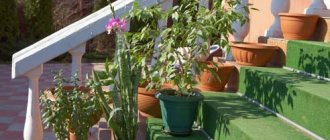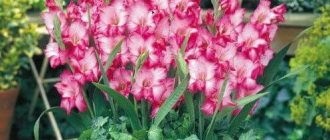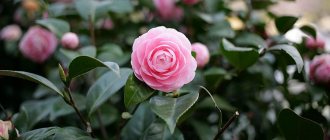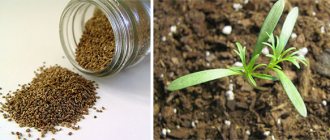Almost all of us have a balcony at home. Some people put all unnecessary rubbish on it, while others keep flowers on the balcony. Some even create a real winter garden from indoor plants.
If you are from the “other” category, then you will probably be interested in the prospect of creating not only a winter garden, but also a summer blooming oasis. With a little effort, you can create a cozy place to relax from a simple balcony that will delight you with its view all year round.
Flowers on the balcony - an island of beauty and freshness
Spring is the time for gardens and balconies to flourish! Flowers on the balcony are not only a decoration for a single apartment, but also for the house as a whole. Most of all, many indoor flowers desire access to the balcony. In the fresh air and natural light they will become much more beautiful.
What indoor flowers can be placed on the balcony in early spring?
During the period when the air temperature at night is still sharply different from the daytime, not all indoor plants can be left “overnight” on the balcony. Subtropical plants tolerate such a change of environment most easily. These are mainly shrubs with dense leathery leaves - aralia, myrtle, laurel, oleander.
Among the blooming indoor flowers:
- Geranium (pelargonium). On the balcony it will bloom with lush and large white, pink, red umbrellas.
- Fuchsia. She looks elegant thanks to her large earrings, the variety of colors and shapes of which is simply surprising.
- Orchids also withstand temperature contrasts well.
When to place flowers on the balcony depends on some factors besides the air temperature.
1. Is your balcony glazed?
Not all house flowers (and annuals) tolerate drafts. For example, tropical ferns, ficus, and begonia prefer to stay in the shade and in a windless place.
2. How well lit is the balcony?
If the balcony is on the south side, then the flowers must be shaded from the sun. All winter they were under artificial light, and with a sudden change in the situation, the leaves could burn. And to prevent the roots of the plants from overheating, the pots must be placed in a box with sand.
3. If the balcony is very high and not glazed.
In this case, decorating the balcony with flowers is not the best idea. But, if you really want to, then the most suitable option is unpretentious, low-growing annuals - marigolds, marigolds.
What is seedling hardening and why is it needed?
The main purpose of hardening seedlings is to prepare them for environmental conditions. After all, young plants just planted in open ground will be actively affected by stronger UV radiation (ultraviolet), cold and gusty winds, and daily temperature fluctuations. And since replanting is already stressful for the plant, if it is not ready for the effects of the above factors, rooting may slow down, leaves will turn yellow (sunburn) and even the death of the plant. In order to best prepare the plant for the conditions that will await it after planting in open ground, it is recommended to harden the seedlings.
How to plant flowers on the balcony
If you are lucky enough to have a large loggia, then in the summer you can make a whole greenhouse out of it.
In order for a blooming balcony to become a real decoration and a source of pride, it is necessary to take into account some rules for selecting and planting flowers.
- separate shade-loving flowers from light-loving flowers;
- take into account the nature of growth;
- by color;
- flowering time and duration of flowering;
- plant height.
- curly or ampelous.
How to choose flowers for a balcony by color
Flowers on the balcony should look beautiful not only from the side of the apartment, but also from the street. Therefore, select flowering plants in such a way that they are in harmony in color with each other and with the color of the walls of the house. Plants in the same color scheme look very beautiful.
Eg:
- Geranium has many shades of red and pink.
- Nasturtium - from bright yellow to orange.
If such a choice seems completely boring, then to create a flower garden on the balcony, select flowers in a harmoniously contrasting color. A combination of blue and orange, yellow and purple flowers looks good, white flowers, silver ones will be combined with almost all flowers, no matter what color they are.
In spring, seedlings of balcony flowers fill all markets and hypermarkets. By purchasing flowers from seedlings, you can accurately decide on the color scheme of the future flower garden on the balcony.
Be sure to check out:
What about summer residents?
Even if you transport plants in your own car, you should wrap each pot in newspaper or old paper during the trip to prevent the soil from crumbling, damaging the pot, or drying out or damaging the leaves. You probably won’t find a more convenient container for transporting potted plants than cardboard boxes. Pack the packaged flowers into boxes and you are ready to go.
How to plant flowers outside the balcony
To begin, select boxes that are wide enough to accommodate 2 (or even 3) rows of flowers:
- The first row, the outer one, is planted with hanging (twisting) flowers (or low-growing ones). For this you can use petunia (urban beauty), climbing geranium, and low-growing nasturtium. They bloom all summer, and nasturtiums until late autumn.
- Second row, medium-height flowers: marigolds, carnations, gillyflower. Marigolds will delight you until the first frost.
- If space permits, plant the third row with climbing flowers. They will rise up and create pleasant coolness on a hot day. In addition, with their beauty they will also provide protection from road soot and dust. Climbing nasturtium, sweet peas or Turkish beans will help you with this. Very often, perennial vines are planted on the balcony - virgin grapes, clematis (it is advisable to cover them for the winter).
Balcony flower boxes and pots surprise with a variety of shapes and colors, which makes the choice much easier. You can also use hanging flowerpots or original pots for balconies, which are installed without fastening.
Flowers on the balcony depending on the direction of the world
Flowers on a sunny balcony, south side
Light-loving flowers include petunia, leftover, geranium, snapdragon, nasturtium, and carnation. However, these flowers will also suffer from the direct scorching rays of the sun. Therefore, you will need to monitor watering especially carefully.
Balcony on the southwest or southeast side
There is sunshine here in the mornings and evenings. During the day, partial shade reigns on the balcony. In such conditions, sun-loving flowers will take root well, as well as some indoor flowers - tradescantia, chlorophytum, begonia, fuchsia. Among the annuals - fragrant tobacco, marigolds. Perhaps these are the best conditions for growing flowers on the balcony in the summer.
Balconies on the north side, or shaded by neighboring buildings
In this case, the choice of balcony colors is not large. You should not grow climbing flowers, so as not to further shade the room. To make the northern balcony a decoration, plant red pelargonium. Its large flowers will be visible from afar and will add brightness and joy. You can plant nemesia and begonia. Flowers for the northern balcony, such as mignonette, impatience, and daisies, will look good up close.
Which indoor flowers love shade and which ones love sun?
Some indoor plants are afraid of direct sunlight; these must be shaded. These are, for example, dracaena, ferns, ivy, fittonia, zamioculcas, spathiphyllum, anthurium, violet. This does not mean that the listed plants need to be completely isolated from the sun - simply providing them with diffused light is enough.
For some plants, contact with direct sunlight can cause severe sunburn. These are, for example, orchids of the genus Phalaenopsis.
In contrast, cacti, ficus, aloe, chlorophytum, dieffenbachia, monstera and crassula tolerate the sun very well.
Houseplant lovers claim that plants that love the sun generally have dense, thick leaves.
Unpretentious and for the south side
The bright summer sun is “to taste” for plants such as geranium, petunia, purslane (does not need frequent watering), marigolds, calendula, snapdragons, pelargonium. Let's look at some of them in more detail.
Geranium
Geranium, or pelargonium, tolerates direct radiation well. She does not get burned - on the contrary, she only enhances flowering.
Care rules and benefits of geranium
- Blooms all summer.
- Loves direct sunlight and high air temperatures (the south side is ideal for growing).
- It is quite unpretentious, but the soil needs to be watered and loosened regularly, since pelargonium quickly absorbs moisture and needs oxygen.
- Loves feeding.
Pelargonium is a heat-loving plant , so don’t rush to take it out onto the balcony in the spring and put it away in the warmth in the fall at the slightest sign of cold weather (when the temperature drops below +10°C).
Geranium is one of those flowers that grow on the windowsill in an apartment in winter and decorate the loggia/balcony in summer. She loves fresh air very much, but is afraid of drafts. If you plan to take the flower into the garden, then around the end of December the flower can be radically pruned. Soon new shoots will appear on it and the plant will be more viable.
To stimulate flowering in the future, starting in February, feed pelargonium twice a week with a liquid solution of mineral fertilizer based on nitrogen, iron and potassium. Do not stop feeding the flower throughout the entire period of growth and flowering.
It is important to choose a suitable pot for geraniums. For a flower 15-20 cm high, a pot with a diameter of 20 cm is suitable.
Petunia
Petunia “loves” southern balconies because it needs intense lighting. Easily tolerates direct midday rays. In general, this is a very unpretentious decorative flower. Not afraid of temperature changes, resistant to diseases.
There are many varieties of petunias with a variety of colors, even almost black. There are hanging varieties, and there are those for flowerpots (they will grow in width).
Care instructions
- Petunia blooms until frost. Like fuchsia, it tolerates acidic soil well.
- Petunia “gets along” in the same flowerpot with geranium, thyme, bacopa, and lobelia.
- The only difficulty is in care : every 2 weeks you need to fertilize for lush flowering and control watering (do not flood). Better slightly dry soil than wet soil.
- You can use one of these preparations as a fertilizer: “Fertika”, “Akverin”, “Ideal”.
- Dense flowering is stimulated by pruning and removing faded flowers.
- There is one nuance in cultivating petunia - a long growing season. To get a flowering bush at the beginning of summer, you need to sow the seeds no later than the New Year (or buy seedlings).
Calendula
One of the most unpretentious potted plants , suitable for growing even by the most inexperienced gardeners.
Calendula feels great both on the sunny south side and in partial shade.
Ordinary garden soil is suitable as soil.
Rules of care
- It tolerates poor soil well, but fertilizing is advisable once every 14 days (humus can be used);
- abundant watering;
- Intense lighting is preferable (at least diffused light is necessary, otherwise the shoots will become very elongated and bloom poorly);
- frequent loosening to provide the flower with access to oxygen.
Disadvantages: after flowering, calendula loses its decorative effect , so it should not be grown in a common pot with other flowers.
Calendula or marigolds are used in folk medicine and even in cooking.
The flower reaches 40-60 cm in height. Low terry varieties are most suitable for balconies and loggias.
From a coloristic point of view, marigolds are combined with bright blue and pink flowers.
Do not plant calendula too thickly (this rule applies to any plant).
Marigold
If you want to have a blooming balcony without much effort, plant marigolds there. In just 1.5-2 months they will delight you with their beauty.
There are many varieties of marigolds. African erect ones reach 1 m in height (miniature varieties are chosen for the balcony, for example, Antigua, 30 cm). Also suitable are French low-growing (Bolero, Orange, Flame) and Mexican thin-leaved (Gnome, Golden Gem, Lulu, Ursula).
Care instructions
Marigolds tolerate bright sunlight and its absence equally easily (they will bloom in cloudy weather, just not so cloudy).
They require virtually no maintenance other than watering. They can grow in any container. They bloom all summer. Not susceptible to disease.
Beginner gardeners are advised to choose rejected marigolds . They can be sown as soon as the threat of frost has passed. Choose a deep, narrow pot, which is due to the characteristics of the roots of marigolds (at least 20-30 cm in depth).
So, the optimal conditions for growing marigolds are:
- intense lighting (ideally south facing);
- correct container , the choice of which depends on the variety;
- nutritious soil (leaf soil, sand, peat, turf in a ratio of 2:1:2:2);
- good drainage.
Plant marigolds at a distance of 15-20 cm from each other.
Snapdragon
Lion's mouth, dog's mouth, biting dragon - these are all names of one flower, of which there are more than 1000 varieties.
Low-growing snapdragon is one of the most unpretentious plants for a balcony. It can even be grown in a cut-off plastic bottle if drainage holes are made in it. But it is better, of course, to use flower pots or boxes. The inflorescences are highly decorative and have a variety of shades.
Rules of care
Flowers are not afraid of direct sunlight, but the roots are sensitive to excess water . Therefore, moderate watering is needed as it dries. It is also necessary to loosen the soil (this can be done with a regular fork). It is advisable to feed the flower a little. Combine fertilizing with watering.
The flower loves spraying.
If you follow simple care rules, snapdragon will delight the eye with its fancy flowers from July until frost.
- You can make the soil yourself (soil from the site, peat, humus), or buy a soil mixture and add turf at a ratio of 1 to 1.
- Do not fill with water. Spray. If it is flooded and rot appears, use “Hom”.
- Fertilize (only 3-4 times per season with nitrophoska).
- It is advisable to keep mosquito nets inside the balcony if you have them (snapdragons are not very friendly with insects).
Snapdragon goes harmoniously with marigolds, forget-me-nots, and phlox.
How to feed indoor flowers and treat them against pests
Fertilizing plants usually alternates with their processing: the interval between them should be at least 10 days. One treatment with anti-pest drugs over the summer will be quite enough. Plant leaves can be treated with green soap two or three more times. Fertilizer feeding is carried out once every two to three weeks, depending on the intensity of the product chosen for this purpose. As practice shows, in this regard it is better not to engage in amateur activities and choose proven products from manufacturers created for a specific group of plants, focusing on the price that you can afford.
What indoor plants can be taken outside (to the balcony)
There are a number of indoor plants that can be taken out onto the balcony or even outside in the summer - and they will calmly continue to live and develop without any harmful consequences for them. These include ficus Benjamin, aspidistra, boxwood, crassula, aloe, Kalanchoe, begonia, primrose, hydrangea, hibiscus, azalea.
Indoor plants that do not tolerate drafts include spathiphyllum and some types of orchids.
Some plants are quite capable of living on the balcony in the summer, but it is better not to take them outside. These are anthurium, arrowroot, monstera, zamioculcas, dracaena.
When to plant pepper seedlings in 2022 according to the lunar calendar?
Gardeners select planting days for peppers, taking into account several factors at the same time, including not only the climate of the region and the variety of the vegetable, but also others. It is often determined when to plant pepper seedlings in 2022 according to the lunar calendar. This is justified, since the celestial body affects the flow of sap in plants. Therefore, gardeners look at the table, which shows favorable days for planting peppers in 2022, and also takes into account dates that are not suitable for planting.
If you left, but the flowers remained...
How to organize watering of indoor plants during vacation, when they are left to their own devices because the owners are not at home?
Firstly, you need to first follow several rules.
About two weeks before departure, refrain from fertilizing your houseplants, as flowers will require more moisture than usual immediately after fertilizing.
Two days before the flowers are left alone at home, cut off all their buds and flowers: they take away moisture.
The day before, remove the plants from the windowsill and place them in a cool part of the room close to each other, if possible providing them with a temperature of 18 to 23 ° C - this will prevent the rapid evaporation of moisture from the soil in the pots.
There are several ways to keep the soil in your pot moist while you're away.
You can water your indoor flowers well before leaving, so that a little water remains in the pan.
Flowerpots with plants can be removed from the tray and immersed in a basin of water so that its level reaches approximately half of the pot. However, with this method you risk exposing the roots of the flowers to rotting, and the flowers themselves to the pests that may appear as a result of this procedure. Wet drainage under the flowerpot has the same effect.
Temperature for plants. Basics
Considering the process of growing plants as a closed system, we can identify the following main factors influencing the result (see Fig. 1):
- sunlight, the main source of energy - carbon dioxide (CO2) content in the air (carbon is the main element used for the formation of new cells) - water, mainly as a source of oxygen included in its composition, necessary for the photosynthesis reaction - ambient temperature air.
Rice. 1
The optimal photosynthesis temperature for most plants in the middle zone is approximately 20-25°C. For example, for sunflower, an increase in temperature in the range from 9 to 19°C increases the intensity of photosynthesis by 2.5 times.
Thus, during photosynthesis, due to light energy, organic substances (carbohydrates) are formed with the participation of chlorophyll. Chlorophyll (from the Greek χλωρός, “green” and φύλλον, “leaf”) is a green pigment that colors plant chloroplasts green.
Thus, the amount of light is an important factor affecting the growth rate of plants.
Also, over many years of evolution, this process has adapted to the day/night cycle. During the day, under the influence of light, water is divided into oxygen and hydrogen, and the plant stores energy and nutrients. At night, in the dark, carbon dioxide, under the influence of stored energy, combines with hydrogen, forming carbohydrate molecules, i.e. the actual growth of culture occurs.
Thus, when growing plants artificially, it is important to ensure not only high illumination, but also the correct cyclicity of light switching on in order to get the best result.
Moving rules
Be careful, aphids!
Warm spring, sunny summer - the time of awakening of nature. However, not only beautiful flowers wake up, but also their numerous pests. They penetrate apartments even through open windows, and there is no need to talk about unglazed balconies. Watch the plants - aphids and spider mites can settle on them. The best way to prevent such troubles is to take a regular shower: from time to time, bring plants into the house and rinse them in the bathroom with water. This procedure is replaced by abundant spraying in the morning and evening.
Be careful, aphids!
Warm spring, sunny summer - the time of awakening of nature. However, not only beautiful flowers wake up, but also their numerous pests. They penetrate apartments even through open windows, and there is no need to talk about unglazed balconies. Watch the plants - aphids and spider mites can settle on them. The best way to prevent such troubles is to take a regular shower: from time to time, bring plants into the house and rinse them in the bathroom with water. This procedure is replaced by abundant spraying in the morning and evening.
From +15 in the morning. Many indoor plants need to be moved out of apartments and into fresh air in the summer. However, the climate of our homes is very different from the weather conditions outside. You need to get accustomed to the “wild” reality gradually. We take out the flowers when the temperature outside the window reaches a stable +15 °C in the morning.
We start with a walk. At first, indoor plants cannot be on the open balcony around the clock. They need to be taken out for a “morning walk” and brought back into the house at noon. After all, it is at this time that the sun is too active and can harm plants that have become weaned from bright light over the winter.
Spring nights are also dangerous for indoor flowers - they are still too deceptive and not warm enough. In addition, flowers do not tolerate sudden changes in temperature, which are typical just for the beginning of spring (and then for autumn).
- 1 of 1
On the picture:
Pots on mobile stands help to move plants from the house to the balcony “for a walk” (with the onset of spring), from the balcony to the house (on cold nights), or into the shade (from the scorching midday sun).
Ready to move! Starting with a few hours a day, we increase the time spent in the fresh air to a full day. But only after the difference between day and night temperatures is minimal.
Create a shadow. While plants can be accustomed to the coolness of the night, the bright midday sun becomes more and more dangerous as summer approaches. To protect green pets, the possibility of shading should be provided: using curtains, blinds, curtains. Open sunny balconies can support succulents, palm trees, yuccas, hibiscus, and citrus fruits. However, in this case it is better to play it safe and create a shadow.
- 1 of 1
On the picture:
On the balcony, on the loggia with the winter garden, the possibility of shading the plants should be provided in order, if necessary, to protect them from the hot rays of the sun.
Return to the apartment. You need to bring plants indoors depending on the weather (as soon as it drops below +15° at night). It is difficult to name the exact month of “return”: some years August will be cold and rainy, but it can be warm at the end of September. Not only the cold, but also prolonged rains cause damage to plants: during this “wet” period, fungal spores multiply. After returning the plant to the apartment, be sure to strengthen the immune system of the patient. For autumn processing it is better to use Zircon.
LiveInternetLiveInternet
—Categories
- Weight loss diet - tips (36)
- Cats video (36)
- Cats - tips, behavior, signs (36)
- Foot care, massage, treatment (35)
- Hair care (33)
- Note to the hostess (30)
- Health - body cleansing (30)
- Planet (30)
- Healthy drinks (28)
- Cities and countries of the Planet (28)
- Healthy vegetables fruits berries (26)
- Pharmacy and medicines (26)
- Cities of Russia (26)
- Palaces and castles (26)
- Honey - benefits, treatment, recipes (25)
- Water heals (25)
- Facial care (24)
- Church holidays (24)
- Astrology (23)
- Health Club Music (23)
- Music video - commercials (23)
- Losing weight (23)
- Hands, massage treatment gymnastics (22)
- Poetry and music (22)
- Evening cinema (22)
- Master class (21)
- Pet healer cats (21)
- Agnes 1 (21)
- Movies series. (20)
- Music playlist (20)
- Memory (20)
- Documentary films (20)
- health-recipes (20)
- Orthodoxy: icons, commandments, prayers (19)
- Health video (19)
- Catmatrix (19)
- books to read and videos (19)
- Vegetable and fruit salads (18)
- ALOE and its benefits (18)
- Neck care, mass, video, gymnastics (18)
- Herbalist (18)
- Health - folk recipes (18)
- Working on a computer (18)
- Pets (17)
- Health - useful tips (17)
- Interiors and design. (17)
- Nature (17)
- Indoor flowers - tips (17)
- Holidays: New Year (17)
- Horoscopes, tests (17)
- Animal World (17)
- Garlic and its benefits (16)
- Melodramas from Olya (16)
- Turmeric for health and beauty (15)
- Youth and health (15)
- Culinary secrets (15)
- Gymnastics for the eyes (15)
- Laughter - health and advice (15)
- Back and posture (14)
- Health: Nordic walking (14)
- Action films, crime melodramas, Russia (14)
- Beautiful music Russia, foreign (14)
- Stars and celebrities (14)
- Cinema Foreign (14)
- Acupressure for health (13)
- Mini films series Russia and foreign (13)
- Health and nutrition (13)
- Tibetan medicine (13)
- Weight loss secrets (13)
- Music Russian romance (13)
- Healing plants (13)
- Cooking: first courses (12)
- Self-body massage (12)
- Cinema comedies Russia and foreign (12)
- Historical films Russia (12)
- Historical films (12)
- Face and body cosmetics (12)
- Music instrumental (12)
- New cinema Russia (12)
- Health of Russia (12)
- Interesting, useful (12)
- Animals videos (12)
- Planet Health (12)
- FAMILY HEALTH CLUB (12)
- Knitting and crochet (12)
- Romantic cinema Russia, foreign (11)
- Stones and magic (11)
- Music Retro (11)
- Beauty health (11)
- music author's song (11)
- Travel (11)
- Good advice (10)
- order and comfort in the house (10)
- Stars in the music room (10)
- Breathing exercises (10)
- Winter preparations (10)
- Music seasons (10)
- Theater - performances and productions (10)
- Ballet, video films (10)
- ZhZL (10)
- music Foreign albums (10)
- music from films (10)
- Chinese medicine (9)
- Home Economics (9)
- Apartment renovation and more. Tips (9)
- Classical music-albums (9)
- Flowers photos, tips (9)
- Desserts are delicious (8)
- Cat paradise (8)
- Nostalgia - music albums (8)
- Dental care, treatment, massage (8)
- Psychology: behavior, emotions (8)
- Foot care, massage, treatment (8)
- Christmas (8)
- Music hits (8)
- Health Secrets (8)
- Music - saxophone sounds (8)
- music Russian Chanson (8)
- Waltz music (8)
- Beauty secrets (8)
- Guardian angels and icons (7)
- Movies for the weekend from OLI (7)
- Spiritual life. Videos, films (7)
- Cartoons (7)
- Fashion and beauty (7)
- Our President V. Putin (7)
- Tango music albums (7)
- Holidays (7)
- Eyes and vision (6)
- Musical films: Russia, foreign (6)
- Odessa-humor, music, video (6)
- New Year's Cinema (6)
- Singing film and theater actors (6)
- photo - planet Earth (6)
- Health - gymnastics, exercises (6)
- Chinese medicine (5)
- Colds and grandma's recipes (5)
- Oriental medicine (5)
- Painting, art, poetry (5)
- Sacred music: albums, videos (5)
- Health massage video (5)
- Foreign detective films (5)
- Video story, blogs (5)
- ORTHODOXY (5)
- music albums (5)
- Walking through films: actors and roles (4)
- Russian cinema (4)
- TV series-films from OLI, Russia (4)
- Agatha Christie films, detective stories (4)
- Music "Golden Collection" (4)
- Music. French chanson, albums (4)
- Exercises for a healthier body (3)
- Laws of the Russian Federation of information and others (3)
- Music about love, albums (3)
- Music nostalgia (3)
- Cinema films of the USSR (3)
- Humor (3)
- Fairy tale films (3)
- Poetry, verses (3)
- Professor Seleznev (3)
- Animal world (3)
- Holiday: Victory Day (3)
- Detective films (3)
- Cat care (3)
- Photos (3)
- Geography of planet Earth (2)
- Flash drives: cats (2)
- Soviet detectives, films (2)
- Cinema show: films about WAR (2)
- Mystical films: Russia, foreign (2)
- Politics, news: Russia and world (2)
- Future world (2)
- Movies for the New Year (2)
- Songs of the war years - music album (2)
- Library: reference books (2)
- All about black cats (1)
- Various icons of Saints (1)
- Ear treatment and care (1)
- AUDIO ALBUMS - retro music (1)
- Kob website - Media films (1)
- Theater - performances and productions (1)
- OUR FILM. Russia 1)
- Dances of the peoples of the world (1)
- Law & Order (1)
- Music - Netulya (1)
- TV channels (1)
- Planet Health (0)
- Painting, art, poetry (0)
- Audio performances Russia and foreign (0)
- Video films of the USSR (0)
- Politics (0)
- Cities and Sirans (0)
- movies drama Russia (0)
- worship (0)
- video room (0)
- (0)
- Health (2)
- cinema (5)
- Cats (3)
- Cooking (9)
- Music (0)
- Useful links and tips (1)
- Handicrafts (8)
- Diary design schemes (0)
- TV online (4)
- Movies online (1)
Related article: How to insulate a balcony ceiling with your own hands
—Search by diary
—Subscription by e-mail
— Regular readers
—Communities
-Statistics
Whom to take out?
Ideal plants for the balcony. The list of indoor plants that can and should be used to decorate a balcony is quite large. For example, these are subtropical palms, yuccas, orchids, indoor roses, oleanders, hydrangeas, bougainvilleas, citrus fruits, clivias, laurels, myrtles, indoor pomegranates, euonymus, hibiscus.
They do not care. They feel equally comfortable in the warm season both at home and on the balcony: aloe, sansevieria, dracaena, pelargonium, fuchsia, zamioculcas.
They do not like moving from home to street: Uzambara violets and many types of cacti.
- 1 of 1
On the picture:
Plants for the balcony look stylish in standardized pots. And if these are special pots with a reservoir for storing water, the normal well-being of the plants even during the absence of the owners is ensured: the upper part of such a pot contains soil with the plant, and the lower part is filled with water that feeds the plant through nylon tubes.
To what temperature can indoor flowers be kept on the balcony?
Every gardener who dreams of having his own greenhouse at home is looking forward to the warm season to bring his flower garden to the balcony. Indeed, in conditions of fresh air and good ventilation, as well as a sufficient amount of sunlight, almost all indoor ornamental plants feel great. But it is important to remember to what temperature you can keep flowers on the balcony, and with the arrival of autumn, send your home garden back “to winter quarters” in time, i.e. bring it into warm rooms on the usual windowsill.
Spathiphyllum does not bloom, what should I do?
Why does spathiphyllum not bloom? Many of its owners have to deal with the lack of flowering of this whimsical plant. It is believed that if grown at home, it will help single women find a soul mate, and establish peace and harmony in families. How to make spathiphyllum bloom at home? Don't be upset: there are several working methods that have been tested in practice by experienced gardeners. These include not only “miraculous” tactics, but also ordinary rules of care, which it wouldn’t hurt to learn about in more detail.
What factors influence the “wintering” time of indoor plants?
There is no definite answer to what temperature you can keep flowers on the balcony - a lot here depends on various factors:
- region of residence (northern or southern);
- climate features, time of season change, average daily temperatures in the region;
- the cardinal direction the balcony faces;
- type and nature of plants (heat-loving, cold-resistant, light-loving, shade-loving, etc.);
- presence/absence of glazing and additional heating of the balcony/loggia.
It is known that the region of residence is one of the important factors on which the characteristics of weather, climate, average daily temperatures and other data important for crop production depend. For example, if in the northern regions of Russia summer comes later, then in the south stable warm weather comes almost in April, which will allow a lover of exotic indoor plants to put his home garden on the balcony without fear of frost. Therefore, it is important to know the average annual temperatures in the region where you live.
The side of the world is another important indicator that affects the time of transferring plants from the room to the balcony. For northern and western loggias/balconies, even in summer there may not be enough sun, and in early spring the temperature in the shade will be lower than in the sun. This must be taken into account when planning to move indoor flowers to the balcony, as well as bring them back into the room.
And the last determining factor that influences when to bring flowers into the room or take them out to the balcony is the presence/absence of glazing and heating. It is clear that glazed balconies are safer in terms of temperatures, and if you have combined a loggia with a room and installed an underfloor heating system (“warm floors”) everywhere, then the question of when to move the plants disappears altogether.
But a standard city apartment has either a glazed or unglazed balcony or loggia. Consequently, the air temperature outside will have a direct effect on the plant.
When to plant flowers in February 2022?
The florist's lunar calendar for February 2022 is a wonderful tip for lovers of flowers and indoor plants. In the last winter month, active work begins on preparing containers for planting seeds and planting planting material. In this article we will also give recommendations on caring for indoor plants.
Exquisite orchids have become a popular indoor plant that fits harmoniously into any interior. Orchids are one of the most beautiful exotic flowers that grow on our planet and belong to the largest family of monocots. They are also called orchids from the name of their family. This plant belongs to the flowering department. There are a huge number of varieties of this plant in the world, which differ in the structure of the column and the location of their stigma. Independent propagation of exotic flowers is painstaking work that requires certain knowledge. The features of the process depend on the type of orchid. At first glance, this is a job for specialists, but following the rules, a novice florist can handle it. We will learn more about the intricacies of propagating orchids by cuttings and more in our article.
In landscape design, ornamental shrubs (cinquefoil, hibiscus, euonymus, and turf) are often used. They decorate gardens, city streets, and parks with their beautiful appearance and lush flowering. This type of plant requires constant and careful care. Pruning is carried out so that the bush maintains its shape, in accordance with the intended design. Quite often, novice owners of suburban areas forget about pruning bushes, concentrating their attention on watering, fertilizing with mineral fertilizers and soil composition. However, when the bushes grow and become more voluminous, pruning ornamental shrubs is simply necessary. Pruning ornamental shrubs in spring for beginners, read right now.
Article rating:
When can you bring indoor flowers to the balcony Link to main publication
Related publications
- DIY balcony decoration in Khrushchev
Temperature range for plant life on the balcony
The standard temperature range in which you can safely keep plants on a balcony without glazing is -10 – +40°C. Below -10°C it is not recommended to keep any plants, even cold-resistant ones, on the balcony. Most types of ornamental plants, especially exotic ones and flowering ones, are very sensitive to cold and may die. But this does not mean that they need to be kept under a cap, like the rose from The Little Prince. On the contrary, moderate cold may even be beneficial for some plant varieties and species. For example, for citrus fruits, slight cooling promotes the formation of fruit ovaries. Coniferous plants also feel great at -10°C.
Typically, you need to bring plants from the balcony into the room in the fall. The exact period of time is determined individually, based on daily temperatures in the region. For central Russia, temperatures down to -10 degrees are reached in late October – early November. For northern latitudes, the first frosts can begin as early as the middle of the first autumn month. For the southern regions, you can keep flowers on the balcony almost until the onset of calendar winter.
It should be remembered that the air temperature on the thermometer is not the only indicator that determines how many degrees you can keep plants on the balcony. On a glazed balcony, the temperature is usually 4-5°C higher than outside, so if the thermometer shows -10°, then the plants in the loggia will be warmer - -5°C. But for open balconies this principle does not work.
Time to bring in flowers
Many indoor flowers are heat-loving and will not withstand wintering on the balcony.
The magnificent flowering of plants on the balcony continues for a long time, often the riot of colors in the balcony boxes does not fade away throughout the first month of autumn. But night and daytime temperature changes begin to negatively affect plants, and some indoor plants begin to prepare for winter.
If you do not bring boxes with geraniums (pelargonium) into a warm room on time, then perennial plants begin to behave like annuals - their growth stops, their leaves begin to turn yellow and fall off. When the location changes, plants caught in heat have a very difficult and long recovery, losing almost all their leaves.
Temperature changes in autumn also have a negative effect on catharanthus, hibiscus and other heat-loving plants.
Several rules for caring for plants in the off-season
In order to maintain the health of indoor plants, their ability to bloom and bear fruit, it is not enough just to maintain the temperature regime. Many growers worry about overcooling their flowers, forgetting that too high temperatures can also be detrimental to their green friends. Few indoor plants tolerate heat well, and direct sunlight is undesirable for most of them. Heat-resistant species include hibiscus, which blooms at temperatures of +50, bougainvillea, dracaena and other plants of tropical origin.
The rest of their brethren wither and die under the influence of high temperatures, begin to fade quickly, stop blooming, and darken their foliage. Therefore, if the housewife did not bring a pot of ficus or violet back into the house on time during a hot afternoon, then she should be prepared to lose her favorite flower.
As for watering, you also need to be very careful here. Moist soil after abundant irrigation has a lower temperature than the air. When the daily temperature outside decreases, and even more so with the onset of the first frost, abundant watering of the pot can lead to the death of the root system. But even during the heat, it is undesirable to water the plants abundantly, especially if drops of water fall on the leaves and trunk: they act like lenses and can cause sunburn in plants. Therefore, when caring for indoor flowers while they are “resting” on the balcony, you should always be careful and attentive.
What are the dangers of hypothermia?
When temperatures drop, flower pots experience severe cooling at night, this is especially scary for plants that have been watered abundantly.
Cold soil often leads to the death of the root system. The roots do not supply the plant with moisture, so it slowly dies. In this case, re-rooting a home flower will help, for which a warm room will be a relief from the cold.
Another danger with sharp fluctuations in night and day temperatures is the disease of indoor flowers with powdery mildew. This dangerous fungal disease develops under negative stressful conditions for growing indoor plants.
A coating appears on the leaves in the form of spilled flour, under which part of the leaf turns brown and dries out. It is difficult to get rid of the disease; you will need to promptly remove the flowers from the balcony and treat them with special preparations (Topaz; Oxychom).
A strong drop in temperature at night (frost) can lead to the death of the above-ground parts of indoor flowers (frostbite).
In this case, overwatered specimens, which are watered at night and very generously, suffer greatly. Restoring frostbitten leaves is impossible; the bushes will lose their decorative appearance for a long time; radical pruning of the damaged parts may be required.











